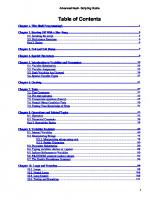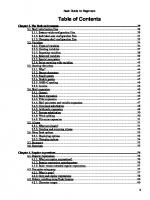Scripting Superpack For Beginners: Python, Powershell, Bash, And Java Mastery 9781839385216
Introducing the Scripting Superpack for Beginners - your ultimate gateway to mastering scripting languages. This bundle
153 39 2MB
English Pages 331 Year 2023
Table of contents :
Introduction
Chapter 1: Introduction to Python Scripting
Chapter 2: Setting Up Your Python Environment
Chapter 3: Variables and Data Types
Chapter 4: Basic Input and Output
Chapter 5: Control Flow: Conditional Statements and Loops
Chapter 6: Functions and Modular Programming
Chapter 7: Working with Lists and Dictionaries
Chapter 8: File Handling and Data Persistence
Chapter 9: Error Handling and Debugging
Chapter 10: Advanced Python Scripting Techniques
Chapter 1: Introduction to PowerShell Scripting
Chapter 2: Getting Started with PowerShell: Basics and Setup
Chapter 3: Working with Variables and Data Types
Chapter 4: Commandlets and Pipelines: Harnessing PowerShell's Power
Chapter 5: Conditional Logic and Loops
Chapter 6: Functions and Script Modules
Chapter 7: Managing Files and Folders with PowerShell
Chapter 8: Remote Scripting and Automation
Chapter 9: Error Handling and Debugging Techniques
Chapter 10: Advanced PowerShell Scripting: Becoming a Ninja
Chapter 1: Getting Started with Bash
Chapter 2: Understanding the Linux Command Line
Chapter 3: Variables and Data Manipulation in Bash
Chapter 4: Control Structures: Conditional Statements and Loops
Chapter 5: Functions and Script Organization
Chapter 6: Text Processing and Manipulation
Chapter 7: File System Operations with Bash
Chapter 8: Working with Permissions and Users
Chapter 9: Automation and Scripting Best Practices
Chapter 10: Advanced Bash Scripting: Taking Your Skills to the Next Level
Chapter 1: Introduction to Java Scripting
Chapter 2: Setting Up Your Java Development Environment
Chapter 3: Basic Java Syntax and Data Types
Chapter 4: Control Flow: Conditional Statements and Loops
Chapter 5: Methods and Functions in Java
Chapter 6: Working with Data Structures: Arrays and Collections
Chapter 7: File Input and Output in Java
Chapter 8: Exception Handling and Debugging
Chapter 9: Object-Oriented Programming in Java
Chapter 10: Advanced Java Scripting Techniques: Becoming a Pro
Conclusion
About Rob Botwright
Introduction
Chapter 1: Introduction to Python Scripting
Chapter 2: Setting Up Your Python Environment
Chapter 3: Variables and Data Types
Chapter 4: Basic Input and Output
Chapter 5: Control Flow: Conditional Statements and Loops
Chapter 6: Functions and Modular Programming
Chapter 7: Working with Lists and Dictionaries
Chapter 8: File Handling and Data Persistence
Chapter 9: Error Handling and Debugging
Chapter 10: Advanced Python Scripting Techniques
Chapter 1: Introduction to PowerShell Scripting
Chapter 2: Getting Started with PowerShell: Basics and Setup
Chapter 3: Working with Variables and Data Types
Chapter 4: Commandlets and Pipelines: Harnessing PowerShell's Power
Chapter 5: Conditional Logic and Loops
Chapter 6: Functions and Script Modules
Chapter 7: Managing Files and Folders with PowerShell
Chapter 8: Remote Scripting and Automation
Chapter 9: Error Handling and Debugging Techniques
Chapter 10: Advanced PowerShell Scripting: Becoming a Ninja
Chapter 1: Getting Started with Bash
Chapter 2: Understanding the Linux Command Line
Chapter 3: Variables and Data Manipulation in Bash
Chapter 4: Control Structures: Conditional Statements and Loops
Chapter 5: Functions and Script Organization
Chapter 6: Text Processing and Manipulation
Chapter 7: File System Operations with Bash
Chapter 8: Working with Permissions and Users
Chapter 9: Automation and Scripting Best Practices
Chapter 10: Advanced Bash Scripting: Taking Your Skills to the Next Level
Chapter 1: Introduction to Java Scripting
Chapter 2: Setting Up Your Java Development Environment
Chapter 3: Basic Java Syntax and Data Types
Chapter 4: Control Flow: Conditional Statements and Loops
Chapter 5: Methods and Functions in Java
Chapter 6: Working with Data Structures: Arrays and Collections
Chapter 7: File Input and Output in Java
Chapter 8: Exception Handling and Debugging
Chapter 9: Object-Oriented Programming in Java
Chapter 10: Advanced Java Scripting Techniques: Becoming a Pro
Conclusion
About Rob Botwright










![Black Hat Bash: Bash Scripting for Hackers and Pentesters - Early Access Edition [Early Access Edition]
1718503741, 171850375X, 9781718503748, 9781718503755](https://ebin.pub/img/200x200/black-hat-bash-bash-scripting-for-hackers-and-pentesters-early-access-edition-early-access-edition-1718503741-171850375x-9781718503748-9781718503755.jpg)